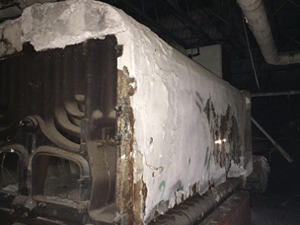Asbestos Removal Cambridge also pronounced phonetically “as·bes·tus” is either of two incombustible, chemical-resistant, fibrous mineral forms of impure magnesium silicate (chemical formulation is Mg3Si2O5(OH)4), used for fireproofing, electrical insulation, building materials, brake linings, and chemical filters. It is made of or contains one or the other of these two mineral forms. [Middle English “asbestos” from Latin asbestos mineral or gem from Greek mineral or gem, “unslaked lime” from asbestos unquenchable].

History
As per most relevant studies, the history of asbestos dates back to thousands of years and stone ages when the human race used it to make flexible objects such as pots, napkins, sheets, utensils, lamps etc., basing on different compositions of the material in concern. Many countries use asbestos for commercial and residential purpose even in the present day modern world, but a lot of them have banned its use citing the health hazards the combination of its compounds causes in different forms.
Usage
Asbestos, popularly known as “magic material” because of its distinct constitution of physical and chemical properties made it usable in the manufacture of thousands of products like floor tiles, road signs, sewage pipes, insulating mattresses, cement building materials, sprayed fire-proofing products, gas masks, friction materials for vehicles such as brakes, clutches etc. Its products are also used in hospitals, boilers, heavy life machinery, railways shipbuilding and dockyards in various forms.
Health Perspective
All types or forms of asbestos are considered to cause serious health issues in humans as well as animals such as tumours and mesotheliomas, especially in a population exposed to occupational use of asbestos (in mines and factories), medically termed asbestosis as the frontline health hazard leading to severe respiratory and lung issues. The WHMIS (Workplace Hazardous Materials Information System) 1988 classification for asbestos is “D2A”, which means “poisonous and infectious material” and other effects being “very toxic”. This includes compounds that can cause asbestosis and even cancer.
Removal
Asbestosis is an irreversible condition, but treatment options do exist to lower its progression and help someone with the disease live for many years after being diagnosed. Medication and breathing treatments are the two most common treatments. All treatment options are palliative, which means they are not potentially curative and are designed only to improve the patient’s quality of life.
Treatment options include various modalities that aid in a patient’s ability to breathe on room air without distress caused by inhalation of asbestos fibers that creates laboured and painful breathing resulting in scarring of lung tissues, which hinders the natural breathing process. Patients with asbestosis should refrain from smoking tobacco as it increases and worsens the risk of asbestosis. Expectorants are suggested to cough and thin out the secretions. Staying well hydrated still is the most accomplished and effective intervention. Supplemental oxygen is prescribed to help with breathing and getting more air into the lungs. Antibiotics and pain medications are prescribed as the prophylactic line of treatment to reduce the risk of infection and inflammation caused by asbestosis. As a last resort, surgery in certain circumstances may be recommended for asbestosis and in rare cases, a lung transplant.

